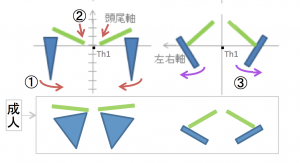田中さん、坂本さんの卒業研究がPLoS ONEに掲載されました。胎児期の上肢帯の形態形成、位置の変化について詳述しました。
- CS18で、烏口骨と上腕骨頭とともに肩甲骨体部を最初に検出
- 肩甲骨下角は尾側方向に拡大したが、頭側はほとんど位置をかえない
- 肩甲骨は胎児期には独特な位置(椎体の前方から側方への移動)、向き( 内部、上方回転)を示す
46. Tanaka S, Sakamoto R, Kanahashi T, Yamada S, Imai H, Yoneyama A, Takakuwa T. Shoulder girdle formation and positioning during embryonic and early fetal human development. PLoS ONE 2020, 15(9): e0238225. https://doi.org/10.1371/journal.pone.0238225
Abstract
Positional information on the shoulder girdle (the clavicle and scapula) is important for a better understanding of the function of the upper limb in the locomotive system as well as its associated disease pathogenesis. However, such data are limited except for information on the axial position of the scapula. Here, we describe a three-dimensional reconstruction of the shoulder girdle including the clavicle and scapula, and its relationship to different landmarks in the body. Thirty-six human fetal specimens (crown-rump length range: 7.6–225 mm) from the Kyoto Collection were used for this study. The morphogenesis and three-dimensional position of the shoulder girdle were analyzed with phase-contrast X-ray computed tomography and magnetic resonance imaging. We first detected the scapula body along with the coracoid and humeral head at Carnegie stage 18; however, the connection between the body and coracoid was not confirmed at this stage. During development, all landmarks on the shoulder girdle remained at the same axial position except for the inferior angle, which implies that the scapula enlarged in the caudal direction and reached the adult axial position in the fetal period. The scapula body was rotated internally and in the upward direction at the initiation of morphogenesis, but in the fetal period the scapula body was different than that in the adult position. The shoulder girdle was located at the ventral side of the vertebrae at the time of initial morphogenesis, but changed its position to the lateral side of the vertebrae in the late embryonic and fetal periods. Such a unique position of the shoulder girdle may contribute to the stage-specific posture of the upper limb. Adequate internal and upward rotation of the scapula could help in reducing the shoulder width, thereby facilitating childbirth. The data presented in this study can be used as normal morphometric references for shoulder girdle evaluations in the embryonic and fetal periods.








